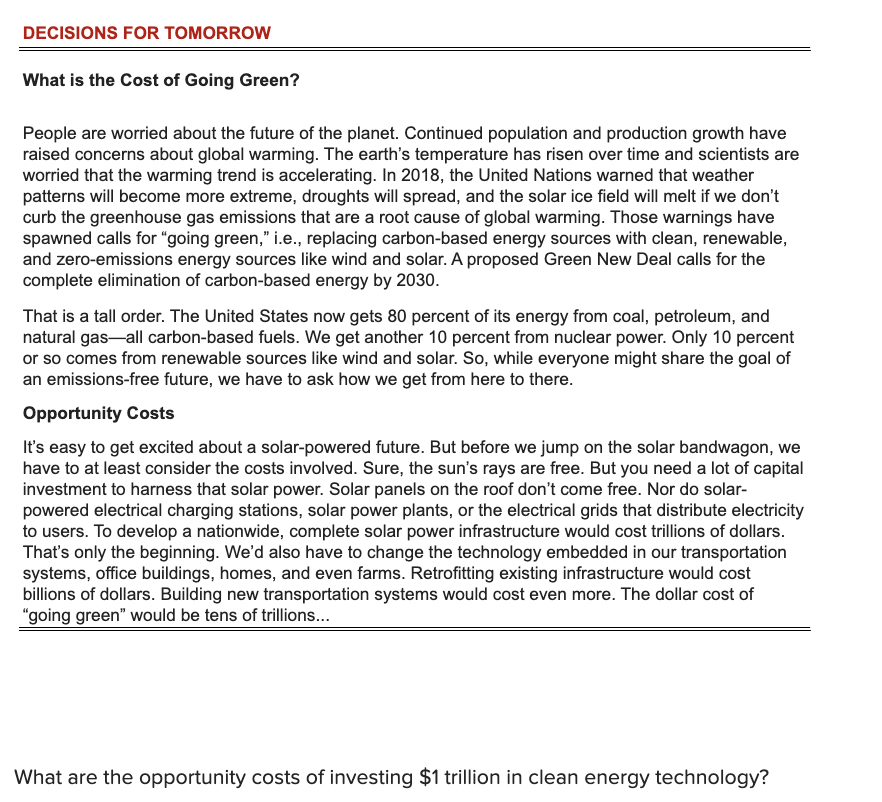? The land used to produce the clean energy technology that could have been used to produce something else ?The millions of dollars spent to produce the clean energy technology ?The higher cost of other sources of energy such as coal, oil, and natural gas ? The goods and services given up to devote resources to producing the clean energy technology
? The land used to produce the clean energy technology that could have been used to produce something else ?The millions of dollars spent to produce the clean energy technology ?The higher cost of other sources of energy such as coal, oil, and natural gas ? The goods and services given up to devote resources to producing the clean energy technology
Chapter6: Population Health
Section: Chapter Questions
Problem 8QAP
Related questions
Question
Click the correct boxes

Transcribed Image Text:DECISIONS FOR TOMORROW
What is the Cost of Going Green?
People are worried about the future of the planet. Continued population and production growth have
raised concerns about global warming. The earth's temperature has risen over time and scientists are
worried that the warming trend is accelerating. In 2018, the United Nations warned that weather
patterns will become more extreme, droughts will spread, and the solar ice field will melt if we don't
curb the greenhouse gas emissions that are a root cause of global warming. Those warnings have
spawned calls for "going green," i.e., replacing carbon-based energy sources with clean, renewable,
and zero-emissions energy sources like wind and solar. A proposed Green New Deal calls for the
complete elimination of carbon-based energy by 2030.
That is a tall order. The United States now gets 80 percent of its energy from coal, petroleum, and
natural gas-all carbon-based fuels. We get another 10 percent from nuclear power. Only 10 percent
or so comes from renewable sources like wind and solar. So, while everyone might share the goal of
an emissions-free future, we have to ask how we get from here to there.
Opportunity Costs
It's easy to get excited about a solar-powered future. But before we jump on the solar bandwagon, we
have to at least consider the costs involved. Sure, the sun's rays are free. But you need a lot of capital
investment to harness that solar power. Solar panels on the roof don't come free. Nor do solar-
powered electrical charging stations, solar power plants, or the electrical grids that distribute electricity
to users. To develop a nationwide, complete solar power infrastructure would cost trillions of dollars.
That's only the beginning. We'd also have to change the technology embedded in our transportation
systems, office buildings, homes, and even farms. Retrofitting existing infrastructure would cost
billions of dollars. Building new transportation systems would cost even more. The dollar cost of
"going green" would be tens of trillions...
What are the opportunity costs of investing $1 trillion in clean energy technology?

Transcribed Image Text:?The land used to produce the clean energy technology that could have been used to produce something else
The millions of dollars spent to produce the clean energy technology
?The higher cost of other sources of energy such as coal, oil, and natural gas
?The goods and services given up to devote resources to producing the clean energy technology
Expert Solution
This question has been solved!
Explore an expertly crafted, step-by-step solution for a thorough understanding of key concepts.
This is a popular solution!
Trending now
This is a popular solution!
Step by step
Solved in 3 steps

Knowledge Booster
Learn more about
Need a deep-dive on the concept behind this application? Look no further. Learn more about this topic, economics and related others by exploring similar questions and additional content below.Recommended textbooks for you



Economics (MindTap Course List)
Economics
ISBN:
9781337617383
Author:
Roger A. Arnold
Publisher:
Cengage Learning



Economics (MindTap Course List)
Economics
ISBN:
9781337617383
Author:
Roger A. Arnold
Publisher:
Cengage Learning


Exploring Economics
Economics
ISBN:
9781544336329
Author:
Robert L. Sexton
Publisher:
SAGE Publications, Inc

Principles of Economics 2e
Economics
ISBN:
9781947172364
Author:
Steven A. Greenlaw; David Shapiro
Publisher:
OpenStax